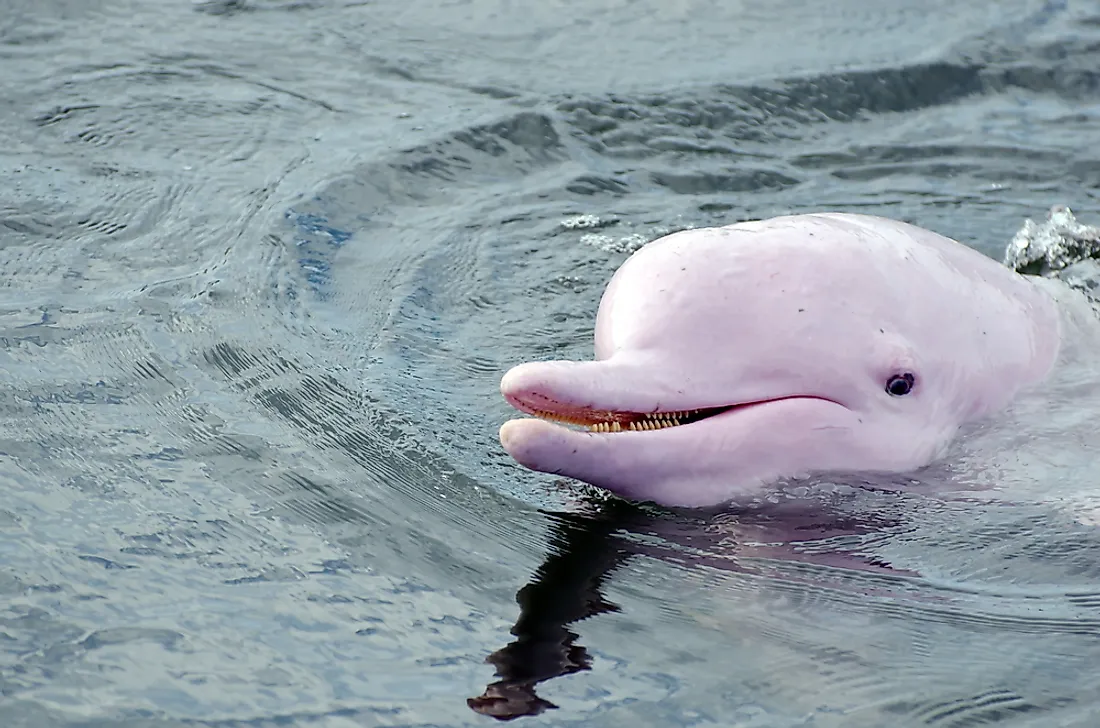How Many Types Of River Dolphins Live In The World Today?

River dolphins are cetaceans that live in freshwater or brackish water habitats. These dolphins are smaller in size than the marine species. Since these dolphins have restricted habitats, they are highly susceptible to threats in their habitat. Fish constitute the majority of their diet. These dolphins usually have well-developed hearing sense but poor eyesight since visibility in their murky water habitats is usually low. Their elongated beaks and conical teeth help them to catch prey moving swiftly in muddy water. River dolphins are classified into five extant species. They are mentioned below:
5. Araguaian River Dolphin
The Araguaian river dolphin or the Inia araguaiaensis has been regarded as a separate species of river dolphin since January 22, 2014. The cetacean lives in Brazil’s Araguaia–Tocantins basin. The color of these dolphins varies from gray to pink. The length of these animals ranges from 1.53 to 2.6 m. The dolphins can sharply turn their heads due to the absence of neck vertebrae. There are about 600 to 1,500 individuals of the Araguaian river dolphin living today. However, they have little genetic diversity which is a threat to their continued existence. Human activities and developmental projects like agriculture, industrial activities, construction of dams, etc., threaten the survival of the dolphins. Fishermen in the region also kill the dolphins by shooting or poisoning them since they claim that the dolphins steal fish from their nets. More extensive surveys need to be conducted to properly classify the population and risk status of the Araguaian river dolphin.
4. Bolivian River Dolphin
The Inia geoffrensis boliviensis or the Inia boliviensis is a subspecies or species of genus Inia. The classification controversy arose when a recent mitochondrial DNA study revealed that the species had diverged from the Amazonian river dolphin about 2.9 million years ago. Hence, while some publications regard it as a separate species, other organizations and groups such as the IUCN consider it to be a subspecies of the Amazon river dolphin. The species was first described by Alcide Dessalines d’Orbigny, a French naturalist who observed it during his stay in Bolivia between 1831 and 1833. He later compared it with a stuffed specimen of the Amazon river dolphin and believed the two dolphins were identical. After further research, it was found that the Bolivian river dolphin had more teeth than the Amazon river dolphin. Also, the range of this dolphin was isolated by the presence of waterfalls and rapids on the Madeira River where these dolphins lived. Then, the Bolivian river dolphin was treated as a separate subspecies. Further studies revealed more differences and genetic studies paved the way for the classification of the Bolivian river dolphin as a separate species by some organizations. International consensus on the classification of this animal is still lacking.
3. Amazon River Dolphin
The Inia geoffrensis or the Amazon river dolphin, also known as the pink river dolphin, is a newly discovered species of dolphin. These dolphins can be as long as 8.2 ft and weigh as much as 185 kg, making them the largest species of river dolphin. Adult Amazon river dolphins are easily distinguished by their pink color. Males of this species are much larger than the females. These cetaceans have a wide prey base and feed on 53 species of fish including piranhas. River turtles and crustaceans are also consumed by these dolphins. Sufficient data regarding the population of these dolphins do not currently exist and thus the IUCN ranks the species as Data Deficient. The Amazon river dolphin suffers from significant threats such as hunting and habitat loss. Entanglement in fishing lines also kills a number of Amazon river dolphins. Although some individuals are kept in captivity, the mortality rate of these dolphins is high under captivity.
2. South Asian River Dolphin
The Platanista gangetica or the South Asian river dolphin is found in the Indian subcontinent. The species is classified in two separate subspecies, the Ganges and the Indus river dolphin. The Indus river dolphin is regarded as Pakistan’s National Mammal and the Ganges river dolphin is recognized as India’s National Aquatic Animal. The former inhabits the Ganga and Brahmaputra rivers of northern India and their tributaries in India, Nepal, and Bangladesh. The latter subspecies can be spotted in the Indus River and its tributaries in Pakistan. The South Asian river dolphin is the only cetacean that swims on its side. The body of this cetacean is brown in color. Males of this species are 2 to 2.2 meters in length while females are 2.4 to 2.6 meters in length. These dolphins feed on fish and shrimp. Both the subspecies of the South Asian river dolphin are classified as Endangered by the IUCN. Several programs have been launched by the Indian government to ensure the survival of the species. Habitat loss, death by entrapment in fishing nets, and habitat pollution are the biggest threats to the species.
1. La Plata Dolphin
The La Plata dolphin is found in southeastern South America in the coastal waters of the Atlantic Ocean. It is the only river dolphin that does not live in exclusively freshwater habitats, instead inhabiting saltwater estuaries. It was first described in 1844. The dolphin is widely known as the Franciscana, but is also sometimes referred to as the cachimbo or the toninha in Brazil. The dolphin is greyish brown in color and grows up to 1.6 m in length. The dolphin also has the longest beak in proportion to body size of any cetacean, reaching 15% in some adults. The La Plata dolphin can live for up to 20 years and reaches sexual maturity at about 2 to 3 years old and gestate for 11 months. They are commonly found alone or in small groups and are hard to spot. They are bottom feeders and consume fish as well as octopus, squid, and shrimp when available. Habitat destruction and water pollution are the largest threats to the species.











